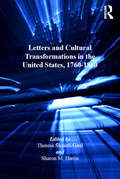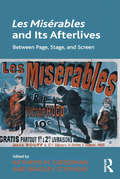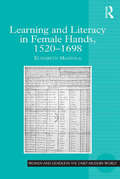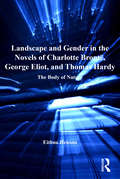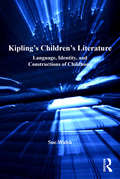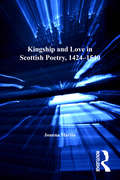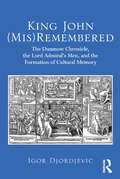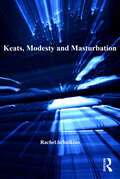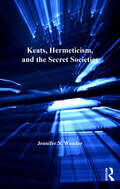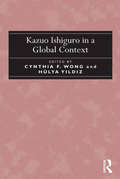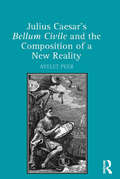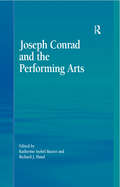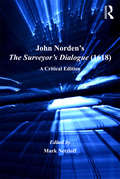- Table View
- List View
Letters and Cultural Transformations in the United States, 1760-1860
by Sharon M. HarrisThis volume illustrates the significance of epistolarity as a literary phenomenon intricately interwoven with eighteenth- and nineteenth-century cultural developments. Rejecting the common categorization of letters as primarily private documents, this collection of essays demonstrates the genre's persistent public engagements with changing cultural dynamics of the revolutionary, early republican, and antebellum eras. Sections of the collection treat letters' implication in transatlanticism, authorship, and reform movements as well as the politics and practices of editing letters. The wide range of authors considered include Mercy Otis Warren, Charles Brockden Brown, members of the Emerson and Peabody families, Margaret Fuller, Elizabeth Stoddard, Catherine Brown, John Brown, and Harriet Jacobs. The volume is particularly relevant for researchers in U.S. literature and history, as well as women's writing and periodical studies. This dynamic collection offers scholars an exemplary template of new approaches for exploring an understudied yet critically important literary genre.
Les Misérables and Its Afterlives: Between Page, Stage, and Screen
by Kathryn M. Grossman Bradley StephensExploring the enduring popularity of Victor Hugo’s Les Misérables, this collection offers analysis of both the novel itself and its adaptations. In spite of a mixed response from critics, Les Misérables instantly became a global bestseller. Since its successful publication over 150 years ago, it has traveled across different countries, cultures, and media, giving rise to more than 60 international film and television variations, numerous radio dramatizations, animated versions, comics, and stage plays. Most famously, it has inspired the world's longest running musical, which itself has generated a wealth of fan-made and online content. Whatever its form, Hugo’s tale of social injustice and personal redemption continues to permeate the popular imagination. This volume draws together essays from across a variety of fields, combining readings of Les Misérables with reflections on some of its multimedia afterlives, including musical theater and film from the silent period to today's digital platforms. The contributors offer new insights into the development and reception of Hugo's celebrated classic, deepening our understanding of the novel as a work that unites social commentary with artistic vision and raising important questions about the cultural practice of adaptation.
Les Misérables and Its Afterlives: Between Page, Stage, and Screen
by Kathryn M. Grossman Bradley StephensExploring the enduring popularity of Victor Hugo’s Les Misérables, this collection offers analysis of both the novel itself and its adaptations. In spite of a mixed response from critics, Les Misérables instantly became a global bestseller. Since its successful publication over 150 years ago, it has traveled across different countries, cultures, and media, giving rise to more than 60 international film and television variations, numerous radio dramatizations, animated versions, comics, and stage plays. Most famously, it has inspired the world's longest running musical, which itself has generated a wealth of fan-made and online content. Whatever its form, Hugo’s tale of social injustice and personal redemption continues to permeate the popular imagination. This volume draws together essays from across a variety of fields, combining readings of Les Misérables with reflections on some of its multimedia afterlives, including musical theater and film from the silent period to today's digital platforms. The contributors offer new insights into the development and reception of Hugo's celebrated classic, deepening our understanding of the novel as a work that unites social commentary with artistic vision and raising important questions about the cultural practice of adaptation.
Learning and Literacy in Female Hands, 1520-1698 (Women and Gender in the Early Modern World)
by Elizabeth MazzolaFocusing on the unusual learning and schooling of women in early modern England, this study explores how and why women wrote, the myriad forms their alphabets could assume, and the shape which vernacular literacy acquired in their hands. Elizabeth Mazzola argues that early modern women's writings often challenged the lessons of their male teachers, since they were designed to conceal rather than reveal women's learning and schooling. Employed by early modern women with great learning and much art, such difficult or ’resistant’ literacy organized households and administrative offices alike, and transformed the broader history of literacy in the West. Chapters treat writers like Jane Sharp, Anne Southwell, Jane Seager, Martha Moulsworth, Elizabeth Tudor, and Katherine Parr alongside images of women writers presented by Shakespeare and Sidney. Managing women's literacy also concerned early modern statesmen and secretaries, writing masters and grammarians, and Mazzola analyzes how both the emerging vernacular and a developing bureaucratic state were informed by these contests over women's hands.
Learning and Literacy in Female Hands, 1520-1698 (Women and Gender in the Early Modern World)
by Elizabeth MazzolaFocusing on the unusual learning and schooling of women in early modern England, this study explores how and why women wrote, the myriad forms their alphabets could assume, and the shape which vernacular literacy acquired in their hands. Elizabeth Mazzola argues that early modern women's writings often challenged the lessons of their male teachers, since they were designed to conceal rather than reveal women's learning and schooling. Employed by early modern women with great learning and much art, such difficult or ’resistant’ literacy organized households and administrative offices alike, and transformed the broader history of literacy in the West. Chapters treat writers like Jane Sharp, Anne Southwell, Jane Seager, Martha Moulsworth, Elizabeth Tudor, and Katherine Parr alongside images of women writers presented by Shakespeare and Sidney. Managing women's literacy also concerned early modern statesmen and secretaries, writing masters and grammarians, and Mazzola analyzes how both the emerging vernacular and a developing bureaucratic state were informed by these contests over women's hands.
Landscape and Gender in the Novels of Charlotte Brontë, George Eliot, and Thomas Hardy: The Body of Nature (The Nineteenth Century Series)
by Eithne HensonExamining a wide range of representations of physical, metaphorical, and dream landscapes in Charlotte Brontë, George Eliot, and Thomas Hardy, Eithne Henson explores the way in which gender attitudes are expressed, both in descriptions of landscape as the human body and in ideas of nature. Henson discusses the influence of eighteenth-century aesthetic theory, particularly on Brontë and Eliot, and argues that Ruskinian aesthetics, Darwinism, and other scientific preoccupations of an industrializing economy, changed constructions of landscape in the later nineteenth century. Henson examines the conventions of reading landscape, including the implied expectations of the reader, the question of the gendered narrator, how place defines the kind of action and characters in the novels, the importance of landscape in creating mood, the pastoral as a moral marker for readers, and the influence of changing aesthetic theory on the implied painterly models that the three authors reproduce in their work. She also considers how each writer defines the concept of Englishness against an internal or colonial Other. Alongside these concerns, Henson interrogates the ancient trope that equates woman with nature, and the effect of comparing women to natural objects or offering them as objects of the male gaze, typically to diminish or control them. Informed by close readings, Henson's study offers an original approach to the significances of landscape in the 'realist' nineteenth-century novel.
Landscape and Gender in the Novels of Charlotte Brontë, George Eliot, and Thomas Hardy: The Body of Nature (The Nineteenth Century Series)
by Eithne HensonExamining a wide range of representations of physical, metaphorical, and dream landscapes in Charlotte Brontë, George Eliot, and Thomas Hardy, Eithne Henson explores the way in which gender attitudes are expressed, both in descriptions of landscape as the human body and in ideas of nature. Henson discusses the influence of eighteenth-century aesthetic theory, particularly on Brontë and Eliot, and argues that Ruskinian aesthetics, Darwinism, and other scientific preoccupations of an industrializing economy, changed constructions of landscape in the later nineteenth century. Henson examines the conventions of reading landscape, including the implied expectations of the reader, the question of the gendered narrator, how place defines the kind of action and characters in the novels, the importance of landscape in creating mood, the pastoral as a moral marker for readers, and the influence of changing aesthetic theory on the implied painterly models that the three authors reproduce in their work. She also considers how each writer defines the concept of Englishness against an internal or colonial Other. Alongside these concerns, Henson interrogates the ancient trope that equates woman with nature, and the effect of comparing women to natural objects or offering them as objects of the male gaze, typically to diminish or control them. Informed by close readings, Henson's study offers an original approach to the significances of landscape in the 'realist' nineteenth-century novel.
Kipling's Children's Literature: Language, Identity, and Constructions of Childhood (Studies in Childhood, 1700 to the Present)
by Sue WalshDespite Kipling's popularity as an author and his standing as a politically controversial figure, much of his work has remained relatively unexamined due to its characterization as 'children's literature'. Sue Walsh challenges the apparently clear division between 'children's' and 'adult' literature, and poses important questions about how these strict categories have influenced critical work on Kipling and on literature in general. For example, why are some of Kipling's books viewed as children's literature, and what critical assumptions does this label produce? Why is it that Kim is viewed by critics as transcending attempts at categorization? Using Kipling as a case study, Walsh discusses texts such as Kim, The Jungle Books, the Just-So Stories, Puck of Pook's Hill, and Rewards and Fairies, re-evaluating earlier critical approaches and offering fresh readings of these relatively neglected works. In the process, she suggests new directions for postcolonial and childhood studies and interrogates the way biographical criticism on children's literature in particular has tended to supersede and obstruct other kinds of readings.
Kipling's Children's Literature: Language, Identity, and Constructions of Childhood (Studies in Childhood, 1700 to the Present)
by Sue WalshDespite Kipling's popularity as an author and his standing as a politically controversial figure, much of his work has remained relatively unexamined due to its characterization as 'children's literature'. Sue Walsh challenges the apparently clear division between 'children's' and 'adult' literature, and poses important questions about how these strict categories have influenced critical work on Kipling and on literature in general. For example, why are some of Kipling's books viewed as children's literature, and what critical assumptions does this label produce? Why is it that Kim is viewed by critics as transcending attempts at categorization? Using Kipling as a case study, Walsh discusses texts such as Kim, The Jungle Books, the Just-So Stories, Puck of Pook's Hill, and Rewards and Fairies, re-evaluating earlier critical approaches and offering fresh readings of these relatively neglected works. In the process, she suggests new directions for postcolonial and childhood studies and interrogates the way biographical criticism on children's literature in particular has tended to supersede and obstruct other kinds of readings.
Kingship and Love in Scottish Poetry, 1424–1540
by Joanna MartinLooking at late medieval Scottish poetic narratives which incorporate exploration of the amorousness of kings, this study places these poems in the context of Scotland's repeated experience of minority kings and a consequent instability in governance. The focus of this study is the presence of amatory discourses in poetry of a political or advisory nature, written in Scotland between the early fifteenth and the mid-sixteenth century. Joanna Martin offers new readings of the works of major figures in the Scottish literature of the period, including Robert Henryson, William Dunbar, and Sir David Lyndsay. At the same time, she provides new perspectives on anonymous texts, among them The Thre Prestis of Peblis and King Hart, and on the works of less well known writers such as John Bellenden and William Stewart, which are crucial to our understanding of the literary culture north of the Border during the period under discussion.
Kingship and Love in Scottish Poetry, 1424–1540
by Joanna MartinLooking at late medieval Scottish poetic narratives which incorporate exploration of the amorousness of kings, this study places these poems in the context of Scotland's repeated experience of minority kings and a consequent instability in governance. The focus of this study is the presence of amatory discourses in poetry of a political or advisory nature, written in Scotland between the early fifteenth and the mid-sixteenth century. Joanna Martin offers new readings of the works of major figures in the Scottish literature of the period, including Robert Henryson, William Dunbar, and Sir David Lyndsay. At the same time, she provides new perspectives on anonymous texts, among them The Thre Prestis of Peblis and King Hart, and on the works of less well known writers such as John Bellenden and William Stewart, which are crucial to our understanding of the literary culture north of the Border during the period under discussion.
King John (Mis)Remembered: The Dunmow Chronicle, The Lord Admiral's Men, And The Formation Of Cultural Memory
by Igor DjordjevicKing John’s evil reputation has outlasted and proved more enduring than that of Richard III, whose notoriety seemed ensured thanks to Shakespeare’s portrayal of him. The paradox is even greater when we realize that this portrait of John endures despite Shakespeare’s portrait of him in the play King John, where he hardly comes off as a villain at all. Here Igor Djordjevic argues that the story of John’s transformation in cultural memory has never been told completely, perhaps because the crucial moment in John’s change back to villainy is a literary one: it occurs at the point when the 'historiographic' trajectory of John’s character-development intersects with the 'literary' evolution of Robin Hood. But as Djordjevic reveals, John’s second fall in cultural memory became irredeemable as the largely unintended result of the work of three men - John Stow, Michael Drayton, Anthony Munday - who knew each other and who all read a significant passage in a little known book (the Chronicle of Dunmow), while a fourth man’s money (Philip Henslowe) helped move the story from page to stage. The rest, as they say, is history. Paying particular attention to the work of Michael Drayton and Anthony Munday who wrote for the Lord Admiral’s Men, Djordjevic traces the cultural ripples their works created until the end of the seventeenth century, in various familiar as well as previously ignored historical, poetic, and dramatic works by numerous authors. Djordjevic’s analysis of the playtexts’ source, and the personal and working relationship between the playwright-poets and John Stow as the antiquarian disseminator of the source text, sheds a brighter light on a moment that proves to have a greater significance outside theatrical history; it has profound repercussions for literary history and a nation’s cultural memory.
King John (Mis)Remembered
by Igor DjordjevicKing John’s evil reputation has outlasted and proved more enduring than that of Richard III, whose notoriety seemed ensured thanks to Shakespeare’s portrayal of him. The paradox is even greater when we realize that this portrait of John endures despite Shakespeare’s portrait of him in the play King John, where he hardly comes off as a villain at all. Here Igor Djordjevic argues that the story of John’s transformation in cultural memory has never been told completely, perhaps because the crucial moment in John’s change back to villainy is a literary one: it occurs at the point when the 'historiographic' trajectory of John’s character-development intersects with the 'literary' evolution of Robin Hood. But as Djordjevic reveals, John’s second fall in cultural memory became irredeemable as the largely unintended result of the work of three men - John Stow, Michael Drayton, Anthony Munday - who knew each other and who all read a significant passage in a little known book (the Chronicle of Dunmow), while a fourth man’s money (Philip Henslowe) helped move the story from page to stage. The rest, as they say, is history. Paying particular attention to the work of Michael Drayton and Anthony Munday who wrote for the Lord Admiral’s Men, Djordjevic traces the cultural ripples their works created until the end of the seventeenth century, in various familiar as well as previously ignored historical, poetic, and dramatic works by numerous authors. Djordjevic’s analysis of the playtexts’ source, and the personal and working relationship between the playwright-poets and John Stow as the antiquarian disseminator of the source text, sheds a brighter light on a moment that proves to have a greater significance outside theatrical history; it has profound repercussions for literary history and a nation’s cultural memory.
Keats, Modesty and Masturbation
by Rachel SchulkinsExamining John Keats’s reworking of the romance genre, Rachel Schulkins argues that he is responding to and critiquing the ideals of feminine modesty and asexual femininity advocated in the early nineteenth century. Through close readings of Isabella; or the Pot of Basil, The Eve of St. Agnes, Lamia and ’La Belle Dame sans Merci,’ Schulkins offers a re-evaluation of Keats and his poetry designed to demonstrate that Keats’s sexual imagery counters conservative morality by encoding taboo desires and the pleasures of masturbation. In so doing, Keats presents a version of female sexuality that undermines the conventional notion of the asexual female. Schulkins engages with feminist criticism that largely views Keats as a misogynist poet who is threatened by the female’s overwhelming sexual and creative presence. Such criticism, Schulkins shows, tends towards a problematic identification between poet and protagonist, with the text seen as a direct rendering of authorial ideology. Such an interpretation neither distinguishes between author, protagonist, text, social norms and cultural history nor recognises the socio-sexual and political undertones embedded in Keats’s rendering of the female. Ultimately, Schulkins’s book reveals how Keats’s sexual politics and his refutation of the asexual female model fed the design, plot and vocabulary of his romances.
Keats, Modesty and Masturbation
by Rachel SchulkinsExamining John Keats’s reworking of the romance genre, Rachel Schulkins argues that he is responding to and critiquing the ideals of feminine modesty and asexual femininity advocated in the early nineteenth century. Through close readings of Isabella; or the Pot of Basil, The Eve of St. Agnes, Lamia and ’La Belle Dame sans Merci,’ Schulkins offers a re-evaluation of Keats and his poetry designed to demonstrate that Keats’s sexual imagery counters conservative morality by encoding taboo desires and the pleasures of masturbation. In so doing, Keats presents a version of female sexuality that undermines the conventional notion of the asexual female. Schulkins engages with feminist criticism that largely views Keats as a misogynist poet who is threatened by the female’s overwhelming sexual and creative presence. Such criticism, Schulkins shows, tends towards a problematic identification between poet and protagonist, with the text seen as a direct rendering of authorial ideology. Such an interpretation neither distinguishes between author, protagonist, text, social norms and cultural history nor recognises the socio-sexual and political undertones embedded in Keats’s rendering of the female. Ultimately, Schulkins’s book reveals how Keats’s sexual politics and his refutation of the asexual female model fed the design, plot and vocabulary of his romances.
Keats, Hermeticism, and the Secret Societies
by Jennifer N. WunderJennifer Wunder makes a strong case for the importance of hermeticism and the secret societies to an understanding of John Keats's poetry and his speculations about religious and philosophical questions. Although secret societies exercised enormous cultural influence during the late eighteenth and early nineteenth centuries, they have received little attention from Romantic scholars. And yet, information about the societies permeated all aspects of Romantic culture. Groups such as the Rosicrucians and the Freemasons fascinated the reading public, and the market was flooded with articles, pamphlets, and books that discussed the societies's goals and hermetic philosophies, debated their influence, and drew on their mythologies for literary inspiration. Wunder recovers the common knowledge about the societies and offers readers a first look at the role they played in the writings of Romantic authors in general and Keats in particular. She argues that Keats was aware of the information available about the secret societies and employed hermetic terminology and imagery associated with these groups throughout his career. As she traces the influence of these secret societies on Keats's poetry and letters, she offers readers a new perspective not only on Keats's writings but also on scholarship treating his religious and philosophical beliefs. While scholars have tended either to consider Keats's aesthetic and religious speculations on their own terms or to adopt a more historical approach that rejects an emphasis on the spiritual for a materialist interpretation, Wunder offers us a middle way. Restoring Keats to a milieu characterized by simultaneously worldly and mythological propensities, she helps to explain if not fully reconcile the insights of both camps.
Keats, Hermeticism, and the Secret Societies
by Jennifer N. WunderJennifer Wunder makes a strong case for the importance of hermeticism and the secret societies to an understanding of John Keats's poetry and his speculations about religious and philosophical questions. Although secret societies exercised enormous cultural influence during the late eighteenth and early nineteenth centuries, they have received little attention from Romantic scholars. And yet, information about the societies permeated all aspects of Romantic culture. Groups such as the Rosicrucians and the Freemasons fascinated the reading public, and the market was flooded with articles, pamphlets, and books that discussed the societies's goals and hermetic philosophies, debated their influence, and drew on their mythologies for literary inspiration. Wunder recovers the common knowledge about the societies and offers readers a first look at the role they played in the writings of Romantic authors in general and Keats in particular. She argues that Keats was aware of the information available about the secret societies and employed hermetic terminology and imagery associated with these groups throughout his career. As she traces the influence of these secret societies on Keats's poetry and letters, she offers readers a new perspective not only on Keats's writings but also on scholarship treating his religious and philosophical beliefs. While scholars have tended either to consider Keats's aesthetic and religious speculations on their own terms or to adopt a more historical approach that rejects an emphasis on the spiritual for a materialist interpretation, Wunder offers us a middle way. Restoring Keats to a milieu characterized by simultaneously worldly and mythological propensities, she helps to explain if not fully reconcile the insights of both camps.
Kazuo Ishiguro in a Global Context
by Cynthia F. Wong Hülya Y?ld?zBringing together an international group of scholars, this collection offers a fresh assessment of Kazuo Ishiguro’s evolving significance as a contemporary world author. The contributors take on a range of the aesthetic and philosophical themes that characterize Ishiguro’s work, including his exploration of the self, family, and community; his narrative constructions of time and space; and his assessments of the continuous and discontinuous forces of history, art, human psychology, and cultural formations. Significantly, the volume attends to Ishiguro’s own self-identification as an international writer who has at times expressed his uneasiness with being grouped together with British novelists of his generation. Taken together, these rich considerations of Ishiguro’s work attest to his stature as a writer who continues to fascinate cultural and textual critics from around the world.
Kazuo Ishiguro in a Global Context
by Cynthia F. Wong Hülya Y?ld?zBringing together an international group of scholars, this collection offers a fresh assessment of Kazuo Ishiguro’s evolving significance as a contemporary world author. The contributors take on a range of the aesthetic and philosophical themes that characterize Ishiguro’s work, including his exploration of the self, family, and community; his narrative constructions of time and space; and his assessments of the continuous and discontinuous forces of history, art, human psychology, and cultural formations. Significantly, the volume attends to Ishiguro’s own self-identification as an international writer who has at times expressed his uneasiness with being grouped together with British novelists of his generation. Taken together, these rich considerations of Ishiguro’s work attest to his stature as a writer who continues to fascinate cultural and textual critics from around the world.
Julius Caesar's Bellum Civile and the Composition of a New Reality
by Ayelet PeerIn his Commentarii de Bello Civili Julius Caesar sought to re-invent his image and appear before his present and future readers in a way which he could control and at times manipulate. Offering a new interpretation of the Bellum Civile this book reveals the intricate literary world that Caesar creates using sophisticated techniques such as a studied choice of vocabulary, rearrangement of events, use of indirect speech, and more. Each of the three books of the work is examined independently to set out the gradual transformation of Caesar's literary persona, in step with his ascent in the 'real' world. By analysing the work from Caesar's viewpoint the author argues that by adroit presentation and manipulation of historical circumstances Caesar creates in his narrative a different reality, one in which his conduct is justified. The question of the res publica is also a key point of the volume, as it is in the Bellum Civile, and the author argues that Caesar purposely does not present himself as a Republican, contrary to commonly held views. Employing detailed philological analyses of Caesar's three books on the Civil War, this work significantly advances our understanding of Caesar as author and politician.
Julius Caesar's Bellum Civile and the Composition of a New Reality
by Ayelet PeerIn his Commentarii de Bello Civili Julius Caesar sought to re-invent his image and appear before his present and future readers in a way which he could control and at times manipulate. Offering a new interpretation of the Bellum Civile this book reveals the intricate literary world that Caesar creates using sophisticated techniques such as a studied choice of vocabulary, rearrangement of events, use of indirect speech, and more. Each of the three books of the work is examined independently to set out the gradual transformation of Caesar's literary persona, in step with his ascent in the 'real' world. By analysing the work from Caesar's viewpoint the author argues that by adroit presentation and manipulation of historical circumstances Caesar creates in his narrative a different reality, one in which his conduct is justified. The question of the res publica is also a key point of the volume, as it is in the Bellum Civile, and the author argues that Caesar purposely does not present himself as a Republican, contrary to commonly held views. Employing detailed philological analyses of Caesar's three books on the Civil War, this work significantly advances our understanding of Caesar as author and politician.
Joseph Conrad and the Performing Arts
by Katherine Isobel BaxterConrad's fiction is characterized by an enduring recourse to the performing arts for metaphor, allegory, symbol, and subject matter; however, this aspect of Conrad's non-dramatic works has only recently begun to come into its own among literary critics. In response to this seminal moment, Joseph Conrad and the Performing Arts offers an exciting, interdisciplinary forum for one of the most interesting and nascent areas of Conrad studies. Adopting a variety of theoretical approaches, the contributors examine major and neglected works within the context of the performing arts: cultural performance in Conrad's Malay fiction; Conrad's use and parody of popular traditions such as melodrama, Grand-Guignol, and commedia dell'arte; Conrad's engagement with the visual culture of early cinema; Conrad's interest in the motifs of shadowgraphy (shadow plays); Conrad's relationship to Shakespeare; and the enduring influence of opera on his work. Taken together, the essays provide, through solid scholarship and richly provocative speculation, new insight into Conrad's oeuvre, and invite future dialogue in the burgeoning field of Conrad and the performing arts.
Joseph Conrad and the Performing Arts
by Katherine Isobel BaxterConrad's fiction is characterized by an enduring recourse to the performing arts for metaphor, allegory, symbol, and subject matter; however, this aspect of Conrad's non-dramatic works has only recently begun to come into its own among literary critics. In response to this seminal moment, Joseph Conrad and the Performing Arts offers an exciting, interdisciplinary forum for one of the most interesting and nascent areas of Conrad studies. Adopting a variety of theoretical approaches, the contributors examine major and neglected works within the context of the performing arts: cultural performance in Conrad's Malay fiction; Conrad's use and parody of popular traditions such as melodrama, Grand-Guignol, and commedia dell'arte; Conrad's engagement with the visual culture of early cinema; Conrad's interest in the motifs of shadowgraphy (shadow plays); Conrad's relationship to Shakespeare; and the enduring influence of opera on his work. Taken together, the essays provide, through solid scholarship and richly provocative speculation, new insight into Conrad's oeuvre, and invite future dialogue in the burgeoning field of Conrad and the performing arts.
John Norden's The Surveyor's Dialogue: A Critical Edition (Literary and Scientific Cultures of Early Modernity)
by Mark NetzloffThis edition provides the first complete, modern version of John Norden's The Surveyor's Dialogue. Norden's text, a series of dialogues between a fictional surveyor and several interlocutors”including a tenant farmer, an aristocrat landowner, a manorial officer, and a socially mobile land buyer”is remarkable for its unique commentary on the agrarian roots of English capitalism. In his extensive introduction, Mark Netzloff situates the text in relation to a number of early modern contexts. He discusses the use of dialogue and other literary forms in proto-scientific writing and the role of print in the increasing professionalism of early surveyors. Netzloff also examines the impact of capital formation on agrarian and manorial class relations, discussing topics such as popular protest and revolt, cottagers and the rural poor, regionalism and urbanization, and the transformation of the natural environment through deforestation, enclosure, and the appropriation of commons. Alongside a thorough annotation of technical and historical terms, the edition provides a list of textual variants among early modern versions of the text. This critical edition of The Surveyor's Dialogue constitutes an important contribution to early modern scholarship, and it will be invaluable to scholars from a range of fields, including the history of science, economic and agrarian history, and literary and cultural studies.
John Norden's The Surveyor's Dialogue: A Critical Edition (Literary and Scientific Cultures of Early Modernity)
by Mark NetzloffThis edition provides the first complete, modern version of John Norden's The Surveyor's Dialogue. Norden's text, a series of dialogues between a fictional surveyor and several interlocutors”including a tenant farmer, an aristocrat landowner, a manorial officer, and a socially mobile land buyer”is remarkable for its unique commentary on the agrarian roots of English capitalism. In his extensive introduction, Mark Netzloff situates the text in relation to a number of early modern contexts. He discusses the use of dialogue and other literary forms in proto-scientific writing and the role of print in the increasing professionalism of early surveyors. Netzloff also examines the impact of capital formation on agrarian and manorial class relations, discussing topics such as popular protest and revolt, cottagers and the rural poor, regionalism and urbanization, and the transformation of the natural environment through deforestation, enclosure, and the appropriation of commons. Alongside a thorough annotation of technical and historical terms, the edition provides a list of textual variants among early modern versions of the text. This critical edition of The Surveyor's Dialogue constitutes an important contribution to early modern scholarship, and it will be invaluable to scholars from a range of fields, including the history of science, economic and agrarian history, and literary and cultural studies.
